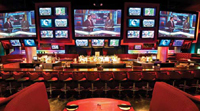Like so many exciting new technologies, high-definition television (HDTV) now is expected as a given by nightclub and bar patrons, who won’t tolerate anything less. The appeal is simple; it yields a better-quality image than standard television does because it has a greater number of lines of resolution. The visual information is some two to five times sharper because the gaps between the scan lines are narrower or invisible to the naked eye.
 “If you just go with a regular TV, people will say, ‘Forget it, I’ll just stay home,’” reports Chris Fuselier, owner of the Blake Street Tavern in Denver, Colo., which features 20 high-def TVs and a 100-inch projection screen HDTV.
“If you just go with a regular TV, people will say, ‘Forget it, I’ll just stay home,’” reports Chris Fuselier, owner of the Blake Street Tavern in Denver, Colo., which features 20 high-def TVs and a 100-inch projection screen HDTV.
Once the leap to HDTV is made, a variety of choices present themselves. “Everything is changing,” says Leo Lesh, owner of five-year-old Leo’s All-Star Sports Bar in Los Angeles. “There is new technology coming out. There is a lot of information out there right now, and it’s kind of scrambled because everybody is trying to figure out how to do it. There is even one company that supposedly is going to do wireless high-def, which I’m interested in seeing.” Of Lesh’s 18 TVs, six are high-definition, including a 61-inch big screen and a projection screen that creates a 104-inch picture — big enough, the bar’s Web site boasts, “to fill an entire wall.”
Take the Lead
You always want to stay ahead of the curve,” says Darren Smith, general manager of the Game-On sports bar in Atlantic City, N.J., which has 90 television screens on-premise. “If you have to completely overhaul your system after two years, maybe you should have bought up a little bit. And when you buy, you shouldn’t buy last year’s technology.” A little education can go a long way to ensure a wise investment. “You can buy some product at Costco that doesn’t look nearly as good,” Fuselier says. “I paid top dollar for Sony XBRs, which is the top of the line. But I do know others have gone the cheap route — ‘Oh, I’ll just go to Costco or Sam’s Club’ — and then it looks like garbage.”
“There are so many different types of systems. I still haven’t elected to go with a matrix system, because it’s so pricey,” Lesh says, referring to the system that uses a board to assign each TV to the appropriate satellite, “even though I know that’s what most people are doing now. “The cheapest one is probably about $8,000,” he continues. “With the cabling, you’re looking at a $10,000 investment just to distribute the signal. The older systems used to have a channel modulator, which is kind of a hokey way of doing it. It’s a lot less expensive, but you’re not going to get the high-def signal. Right now, basically I have a satellite assigned to almost every TV.”
Don’t Waste It
Operators should make sure to get all they can out of whatever system they have. Lesh calls it “amazing how many owners have put in high-def TVs but aren’t really getting the high-def signal to it. What they’re doing is running an analog signal to these high-def TVs, so they end up starved for information. The standard signal was the 480. If you’re punching a 480 into a 1,080 TV, well, you can do the math. It’s got a third of the signal it’s looking for, and the picture shows it.” “Truth be told,” Game-On’s Smith concludes, “at the end of the day the wow factor is in the number of TVs, and the gee whiz factor is in the HD.”
